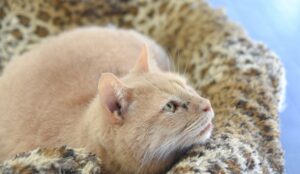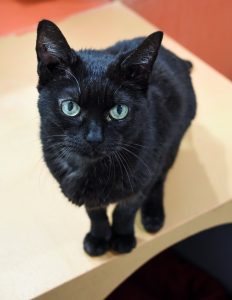 I recently came upon a headline, “What we still don’t know about black holes.”
I recently came upon a headline, “What we still don’t know about black holes.”
It made me think of perennial questions, and perennial plants, and the smart, short-lived flowers we call cats.
 What we still don’t know about black holes is what happens to the stars that close their eyes, hold their noses, and cannonball into the great wide mystery.
What we still don’t know about black holes is what happens to the stars that close their eyes, hold their noses, and cannonball into the great wide mystery.
Are they gone?
Are they reborn?
Do they join some grand graced disco ball, where every once-chipped piece of glass now makes merry in a perpetual party?
Do they get to hang out with the cats and flowers we can’t see anymore down here?
We miss them mightily this time of year, don’t we? If ever our eyes yearned for a single measly marigold, if ever our arms ached for Bucca and Bellamy and Miyoko and Mishush, it’s in December. The winter ache is enough to make you seal the gaping holes in your heart.
 But be careful with that cement. This sort of safety is only yours if you’re prepared never to let in another shooting star.
But be careful with that cement. This sort of safety is only yours if you’re prepared never to let in another shooting star.
If cats have a great deal in common with stars — and never, ever was there a species more celestial — they may have even more kinship with plants.
Prone to twine and vine and wrap themselves wildly around the world, cats can be Steven sequoias or Pepita portulacas, but they can’t help but bloom.
Perpetually, but not perennially. And dang the black holes and wizened winters that claim them all.
When I was a child, I furrowed my little brow on the day I learned the difference between “annual” and “perennial” flowers. The former were some of my favorites, zestful zinnias and gentle geraniums and sweet soulful sunflowers, but they were born to die after just one winning season. The latter were sturdy, survivors, tough enough to wait out the winter and win their way through the hard soil each spring.
Walking around the garden center with my Dad, the prince of portulacas, the grand duke of geraniums, my little heart decided to prefer the perennials. A few light years later, I know why: I didn’t have the courage to love the annuals.
The annuals, like love, need to be replanted and replanted and replanted.
The annuals, like kittens and stars and Dads, are not immortal.
The annuals, like old cats and light, slip into the black holes, slip into secrets like pajamas, slip out of our sight.
But what we don’t know about black holes is that we don’t have to be afraid of black holes and endings.
 We can, of course; and we will, over and over and over again.
We can, of course; and we will, over and over and over again.
We are harrowed little hearts with furrowed brows in the garden center and the cat sanctuary, wearing our losses like charms around our necks. Each adieu offers us our own tumbling trip down the black hole: Would you like a ticket to despair today? The Cynicism Cafe is always open. The unholy hollow is ever-ready to swallow your heart and tell you that all the loss is proof that life is less kind than you hoped when you were a child.
But you, like Steven and Pepita and Bucca and Bellamy and stars and flowers past and present, are made of stronger stuff.
You, like every kitten ever born, are an active galaxy.
Active galaxies are known for their “much-higher-than-normal luminosity.” The light at their core is so powerful, it emits thousands of times the energy of a “normal” galaxy. Picture the hub of nubbins at the heart of a sunflower, or the yellow button asking to be pressed in the center of every daisy.
But the unsinkable energy of an active galaxy doesn’t look quite like ordinary light. It’s quite literally on its own wavelengths, plural, including gamma rays and radio waves.
And at the hot, holy heart of an active galaxy, driving all the perpetual, perennial light, is a supermassive black hole.
What we don’t know about black holes and bad news and brief blooms and short lives is that they bear gifts we can glimpse no other way.
It’s up to us if we’ll replant and replant and replant love and light every year, every day, every hour.
 Death and life spin like nebulas at Tabby’s Place, their fingers touching and parting like strangers in the night or lovers through a gate. One day we welcome Kiko; the next we kiss Faye into the long dreamtime.
Death and life spin like nebulas at Tabby’s Place, their fingers touching and parting like strangers in the night or lovers through a gate. One day we welcome Kiko; the next we kiss Faye into the long dreamtime.
We’re not permitted the luxury of forgetting that life is fragile. We’re not allowed the illusion that we know everything about black holes.
We’re given great galloping gallons of grace to adore our annuals and our shooting stars, exactly as they are, for exactly the amount of time we’ve been given to share.
In this season of little light and large hope, love is at supermoon-size over Tabby’s Place. We can’t help but feel the presences we no longer see; we can’t help but breathe their names as we step outside the sanctuary into the un-patronizing air of December. There are no sunflowers or geraniums or kittens in the bleak midwinter.
But grace is incarnate in every fragile, fiery, here-for-now, loved-for-ever star in our sky.
And while we may not know much about black holes, every gardener knows that winter has its own work.
So let’s keep replanting and replanting and replanting. Whether our loves are here for an hour or two decades, whether they are annuals or perennials, whether or not we believe they will burst forth from the black hole into the Light that loves us all, we’ll dare to give them our entire hearts in the hours we’re given.
We are given so, so, so much grace.
May we give and plant and glitter with the courage of cats and children and saints and angels and stars who know the light that outshines the final darkness.
